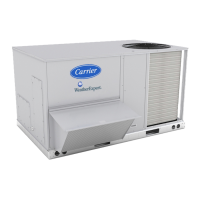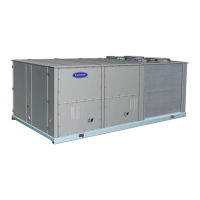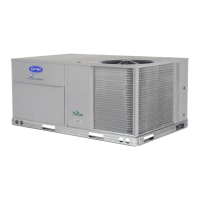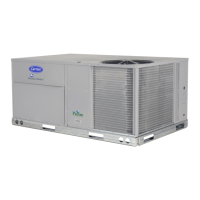91
The algorithm will calculate a Start Bias time in minutes us-
ing the following equations:
If (space temperature > occupied cooling set point)
Start Bias Time = (space temperature – occupied cooling set
point)* TCS.C
If (space temperature < occupied heating set point)
Start Bias Time = (occupied heating set point – space
temperature)*TCS.H
When the Start Bias Time is greater than zero the algorithm
will subtract it from the next occupied time to calculate the new
start time. When the new start time is reached, the Temperature
Compensated Start mode is set (Operating Modes
MODE
T.C.ST ), the fan is started and the unit controlled as in an occu-
pied state. Once set, Temperature Compensated mode will stay
on until the unit goes into the Occupied mode. The Start Bias
Time will be written into the CCN Linkage Equipment Table if
the unit is controlled in DAV mode. If the Unoccupied Econo-
mizer Free Cool mode is active (Operating Modes
HVAC =
“UNOCC FREE COOL”) when temperature compensated
start begins, the Unoccupied Free Cool mode will be stopped.
Carrier Comfort Network
®
(CCN) — It is possible
to configure the ComfortLink controls to participate as an ele-
ment of the Carrier Comfort Network (CCN) system directly
from the local display. This section will deal with explaining
the various programmable options which are found under the
CCN sub-menu in the Configuration mode.
The major configurations for CCN programming are locat-
ed in the local displays at Configuration
IAQ
CCN. See
Table 61.
CCN Address (
CCNA) — This configuration is the CCN ad-
dress the rooftop is assigned.
CCN Bus Number (
CCNB) — This configuration is the CCN
bus the rooftop is assigned.
CCN Baud Rate (
BAUD) — This configuration is the CCN
baud rate.
CCN Time/Date Broadcast (
TM.DT) — If this configuration
is set to ON, the control will periodically send the time and date
out onto the CCN bus once a minute. If this device is on a CCN
network then it will be important to make sure that only one
device on the bus has this configuration set to ON. If more than
one time broadcaster is present, problems with the time will
occur.
NOTE: Only the time and date broadcaster can perform
daylight savings time adjustments. Even if the rooftop is stand
alone, the user may want to set this to ON to accomplish the
daylight/savings function.
CCN OAT Broadcast (
OAT.B) — If this configuration is set
to ON, the control will periodically broadcast its outside-air
temperature at a rate of once every 30 minutes.
CCN OARH Broadcast (
ORH.B) — If this configuration is
set to ON, the control will periodically broadcast its outside air
relative humidity at a rate of once every 30 minutes.
CCN OAQ Broadcast (
OAQ.B) — If this configuration is set
to ON, the control will periodically broadcast its outside air
quality reading at a rate of once every 30 minutes.
Global Schedule Broadcast (
G. S . B ) — If this configuration is
set to ON and the schedule number (SCH.N) is between 65 and
99, then the control will broadcast the internal time schedule
once every 2 minutes.
CCN Broadcast Acknowledger (
B.ACK) — If this configu-
ration is set to ON, then when any broadcasting is done on the
bus, this device will respond to and acknowledge. Only one de-
vice per bus can be configured for this option.
Schedule Number (
SCH.N) — This configuration determines
what schedule the control may follow.
SCH.N = 0 The control is always occupied.
SCH.N = 1 The control follows its internal time sched-
ules. The user may enter any number
between 1 and 64 but it will be overwritten
to “1” by the control as it only has one
internal schedule.
SCH.N = 65-99 The control is either set up to receive to a
broadcasted time schedule set to this
number or the control is set up to broadcast
its internal time schedule (G. S . B ) to the
network and this is the global schedule
number it is broadcasting. If this is the case,
then the control still follows its internal time
schedules.
Accept Global Holidays? (
HOL.T) — If a device is broad-
casting the time on the bus, it is possible to accept the time yet
not accept the global holiday from the broadcast message.
Override Time Limit (
O.T.L) — This configuration allows
the user to decide how long an override occurs when it is initi-
ated. The override may be configured from 1 to 4 hours. If the
time is set to 0, the override function will become disabled.
Timed Override Hours (
OV.EX) — This displays the current
number of hours left in an override. It is possible to cancel an
override in progress by writing “0” to this variable, thereby
removing the override time left.
SPT Override Enabled? (
SPT.O) — If a space sensor is pres-
ent, then it is possible to override an unoccupied period by
pushing the override button on the T55 or T56 sensor. This
option allows the user to disable this function by setting this
configuration to NO.
T58 Override Enabled? (
T58.O) — The T58 sensor is a CCN
device that allows cooling/heating set points to be adjusted,
space temperature to be written to the rooftop unit, and the abil-
ity to initiate a timed override. This option allows the user to
disable the override initiated from the T58 sensor by setting
this option to NO.
Global Schedule Override? (
GL.OV) — If the control is set
to receive global schedules then it is also possible for the global
schedule broadcaster to call out an override condition as well.
This configuration allows the user to disable the global sched-
ule broadcaster from overriding the control.
Alert Limit Configuration — The ALLM submenu is
used to configure the alert limit set points. A list is shown in
Table 62.
SPT Low Alert Limit/Occ (
SP.L.O) — If the space tempera-
ture is below the configurable occupied SPT Low Alert Limit
(SP.L.O), then Alert 300 will be generated and the unit will be
stopped. The alert will automatically reset.
SPT High Alert Limit/Occ (
SP.H.O) — If the space tempera-
ture is above the configurable occupied SPT High Alert Limit
(SP.H.O), then Alert 301 will be generated and the unit will be
stopped. The alert will automatically reset.
SPT Low Alert Limit/Unocc (
SP.L.U) — If the space tem-
perature is below the configurable unoccupied SPT Low Alert
Limit (SP.L.U), then Alert 300 will be generated and the unit
will be stopped. The alert will automatically reset.
SPT High Alert Limit/Unocc (
SP.H.U) — If the space tem-
perature is above the configurable unoccupied SPT High Alert
Limit (SP.H.U), then Alert 301 will be generated and the unit
will be stopped. The alert will automatically reset.
EDT Low Alert Limit/Occ (
SA.L.O) — If the space tempera-
ture is below the configurable occupied evaporator discharge
temperature (EDT) Low Alert Limit (SA.L.O), then Alert 302
will be generated and cooling operation will be stopped but
heating operation will continue. The alert will automatically
reset.

